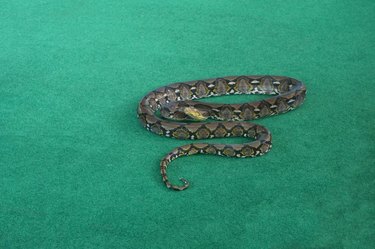Creating a habitat for pet reptiles is challenging, particularly selecting ground cover. In the wild, urine is absorbed into the soil, which is not true in an enclosure. Some reptile enthusiasts opt for a reptile carpet. A reptile carpet is a liner used on the bottom of reptile cages that provides a texture that is not damaging to feet and claws.

Video of the Day
Reptile carpets must be cleaned regularly; otherwise, urine and fecal matter will attract bacteria and fungus growth that is harmful to a reptile's health. Carpet fibers unfortunately cling to excrement, so it's recommended that you do a surface cleaning daily and a more thorough cleaning weekly. Sanitizing a reptile carpet is time consuming but necessary, and different methods have different pros and cons.
Video of the Day
Hand-washing a reptile carpet
Like many pet products, the variety of reptile carpets is numerous. Some are soft liners made from recycled plastic bottles, while others are designed to replicate natural environments, such as sand or moss. Sometimes, reptile carpets can be easily rinsed off under running water and then dried. Others require a more thorough hand-washing.
Hand-washing is labor intensive. Obviously, step one is to put your reptile in a safe place before removing the carpet. Shake loose feces into the garbage. Then, submerge the carpet into cool to warm soapy water for about 20 minutes; hot water might shrink the carpet. Remove the carpet and scrub each side gently with a brush. Repeat if necessary.
Using clean water, thoroughly rinse all soap from the carpet. Spray it with disinfectant purchased from the pet store following the manufacturer's instructions. Air dry before returning the carpet to the reptile's enclosure.
Machine-washing a reptile carpet
Reptile carpets are prone to supporting bacterial growth, so they require diligent cleaning. Cleaning by hand each week might be too big of a chore. Some commercial reptile carpets are machine-washable, but that will increase the wear on your carpet, and you'll have to replace it more frequently.
However, machine-washing is usually more thorough than hand-washing, reducing the number of stains on the carpet. First, safely remove the reptile carpet liner from the enclosure and shake as much dirt into a garbage as possible. Then, wash it individually on a gentle cycle and a warm or cool water setting. Usually, you'll be able to machine-wash a carpet four times before it needs to be replaced.
Drying a reptile carpet
Air drying a reptile carpet is the best idea because using a dryer will increase the wear on the liner. Machine-washed reptile carpets are essentially dry after the spin cycle and might only need an hour or two to dry thoroughly. A hand-washed reptile carpet, even one that's thoroughly wrung out, will require a longer drying time. For this reason, you'll likely need more than one reptile carpet to alternate them between washings.
Best lizards for pets
If the amount of work necessary to keep your pet reptile's cage clean doesn't deter you from having one of these interesting pets, you'll need to know which lizards make the best pets. Reptiles require more care than many realize, but there are a few species recommended for beginners. Bearded dragons are the most popular reptile pet because they are sociable, grow no longer than 2 feet, live 10 to 15 years, and require moderate temperatures. All reptiles need regulated heat sources.
Iguanas are also popular reptile pets, but they need very large enclosures that include a water source and very carefully monitored temperature controls. Iguanas are herbivores, so they're good for people who are not comfortable feeding their reptile live food. Unlike bearded dragons, iguanas generally do not like to be handled.